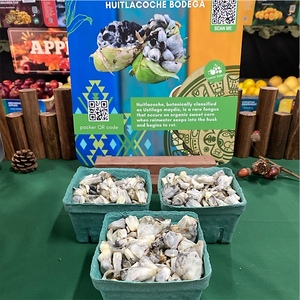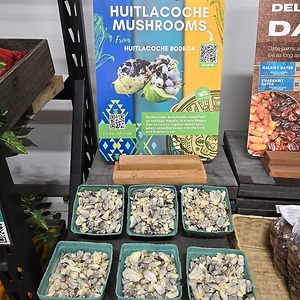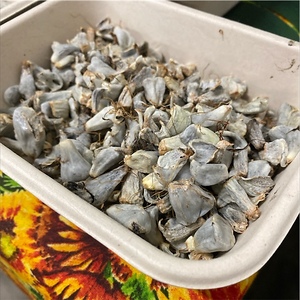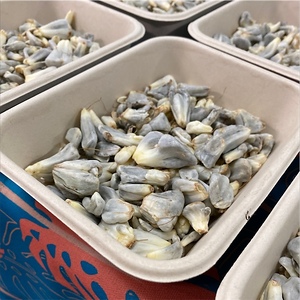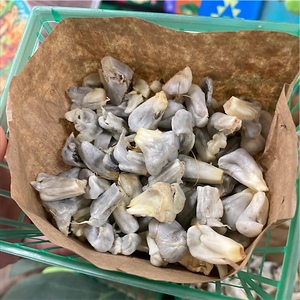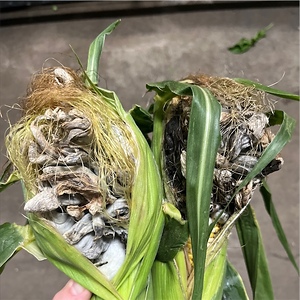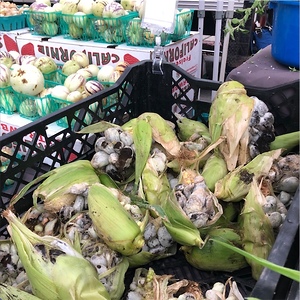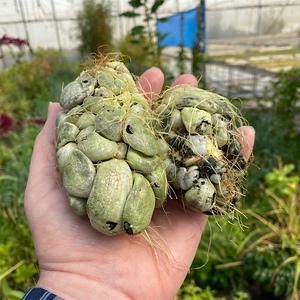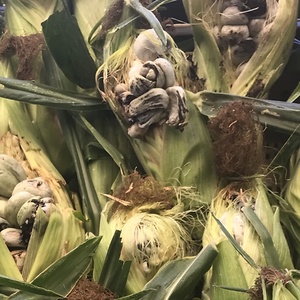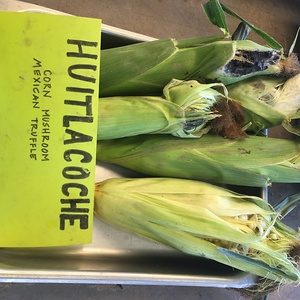


Huitlacoche Mushrooms
Estimated Inventory, lb : 0
Description/Taste
Huitlacoche is a fungus that infects and settles on the surface of corn ears. The fungus develops from spores, and as it matures, it forms swollen cells known as galls that vary in size, depending on growing conditions, generally around 2 to 12 centimeters in length. The galls have a puffy, oval to oblong nature and can often look like they are exploding from the corn ear. The galls typically appear in shades of silver and grey, eventually turning black with maturity, giving the mass a burnt or scorched look. The swollen cells also have a spongy, soft, and mushroom-like texture when young, becoming firm, dry, and coarse as it ages. Inside the gall, there are many interwoven threads and black spores. When young, Huitlacoche releases a subtly earthy scent with a soft, chewy, and spreadable consistency. The young galls can be consumed raw or cooked and have a woodsy, sweet, sour, earthy, bitter, nutty, and smoky taste likened to a savory blend of mushrooms mixed with corn.
Seasons/Availability
Fresh Huitlacoche is available in the late spring through early winter. In frozen form, it is available year-round.
Current Facts
Huitlacoche, botanically classified as Ustilago maydis, is a rare, naturally occurring fungus belonging to the Ustilaginaceae family. The parasitic fungus blooms on corn species that have been punctured or damaged, and the fungus spores feed off the plant before the ears can fully develop. The fungus often spreads through corn fields from spores in the air or rainwater seeping into the corn husk, and as it matures, bulbous, swollen galls grow over the corn's surface. These edible galls are called Huitlacoche in Mexico and are also known as Nanha, Cuitlacoche, Corn Mushroom, Corn Truffles, Mexican Truffles, and Corn Smut. Huitlacoche is only available for a short season each year, and the galls are harvested young, approximately 16 to 18 days after the fungus infiltrates the corn. Throughout Mexico, Huitlacoche is a culinary delicacy favored for its complex taste, and the galls are used to infuse flavoring and texture into a wide array of raw and cooked dishes.
Nutritional Value
Huitlacoche changes the nutritional components of corn. The galls are a source of fiber to regulate the digestive tract, vitamin C to boost the immune system, calcium to build strong bones and teeth, and other nutrients, including phosphorus, manganese, magnesium, and omega-3 and omega-6 fatty acids. Huitlacoche also provides lysine, an essential amino acid not commonly found in standard corn kernels. Lysine assists the body in absorbing calcium and developing collagen. In Mexico, Huitlacoche is used in natural medicines to treat diarrhea and other digestive issues and is thought to encourage uterine contractions. It is also used in topical products to improve the skin.
Applications
Huitlacoche has a smoky, earthy, sweet, and bitter taste suited for fresh and cooked preparations. When picked fresh, the enlarged galls can be lightly torn apart by hand and sprinkled over salads. The galls can also be chopped into salsas, blended into creams and sauces, or added to guacamole. In addition to fresh preparations, Huitlacoche can be cooked into soups and stews, mixed into tamale filling, incorporated into egg-based recipes such as omelets and poached eggs, or mixed into corn patties. It is important to note that the galls will transition from grey to black when heated and can be used in any recipe calling for mushrooms. In Mexico, Huitlacoche is famously used in quesadillas, especially in Oaxaca, folded into crepes, added to empanadas, baked into sausage, cheese, and corn dips, or used in flan as a savory twist. Huitlacoche is also used in mole prieto, a popular dish in the state of Tlaxcala. Huitlacoche pairs well with aromatics such as garlic, onions, and chile peppers, squash blossoms, tomatoes, meats including poultry, beef, and chorizo, seafood such as scallops, shrimp, lobster, and monkfish, truffles, and epazote. When harvested fresh, Huitlacoche should be immediately consumed for the best quality and flavor. Canned items will last longer, staying good in the refrigerator once opened for a few weeks.
Ethnic/Cultural Info
Huitlacoche is derived from classical Nahuatl, the language spoken among Central and Southern Mexico indigenous populations. In modern Nahuatl, Huitlacoche is spelled Cuitlaochin or Cuitlacoche, and linguists heavily debate the meaning of the name. Some etymologists claim Cuitlacoche is taken from words that translate to "sleeping excrescence," describing how the fungus keeps the corn kernels from developing, symbolized as "sleeping." Beyond Mexico, the Hopi tribe in North America considered Huitlacoche to be a delicacy. The Hopi called it "Nanha" and harvested the fungus when it was young and tender, boiling it until just done and sautéing in butter until crisp. Another North American tribe, the Zuni, called the fungus "Corn-Soot" and believed it was the "generation of life."
Geography/History
Huitlacoche is native to Mexico and has been developing on corn ears since ancient times. The fungus typically appears during rainy seasons and infects ears of corn that have been damaged by animal bites, weather, or floods. Throughout Mexico, Huitlacoche has historically been viewed with varying opinions, from a rare disease to a delicacy. It is unknown when the fungus was used as a desired culinary ingredient, but some experts believe the Aztecs treasured the fungus as a food source. The oldest image of Huitlacoche appears in the "Historia General de las Cosas de Nueva España," translating to "General History of the Things of New Spain," written by Franciscan missionary Bernardino de Sahagún. Huitlacoche was also mentioned in records during colonial times in Mexico as a food source among indigenous populations. In the 20th century, Huitlacoche was adopted as a nationally acclaimed culinary ingredient, and the fungus became an essential seasonal crop throughout Mexico. Huitlacoche was also valued by the Zuni and Hopi people groups in North America as a medicinal, culinary, and cultural ingredient. Despite its value in Mexico, Huitlacoche was not as warmly received among corn growers in the United States, and historically, the fungus was viewed with contempt for its crop-destroying nature. The United States Department of Agriculture, or USDA, spent years developing hybrid corn species to be resistant to the fungus, and corn stalks infected with the fungus were immediately removed from fields. In the 20th century, as Huitlacoche was revered across Mexico, chefs in the United States began promoting the unusual culinary ingredient to change the narrative surrounding the edible fungus. Josefina Howard, chef at Rosa Mexicano in New York, is famous for the dinner that she hosted with the James Beard Foundation in 1989. Huitlacoche was showcased as Mexican Truffle and was used in every dish served during the dinner. By the mid-1990s, the USDA changed its opinion of the fungus and allowed select farms in Florida and Pennsylvania to test-grow fields of infected corn as a culinary ingredient. Today Huitlacoche production is centered in Mexico and is grown as a delicacy in Chihuahua, Veracruz, Hidalgo, Puebla, Sonora, Tlaxcala, Oaxaca, and Central Mexico. When in season, Huitlacoche is sold through fresh markets, direct from growers, restaurants, and street vendors in Mexico.
Recipe Ideas
Recipes that include Huitlacoche Mushrooms. One
Podcast



